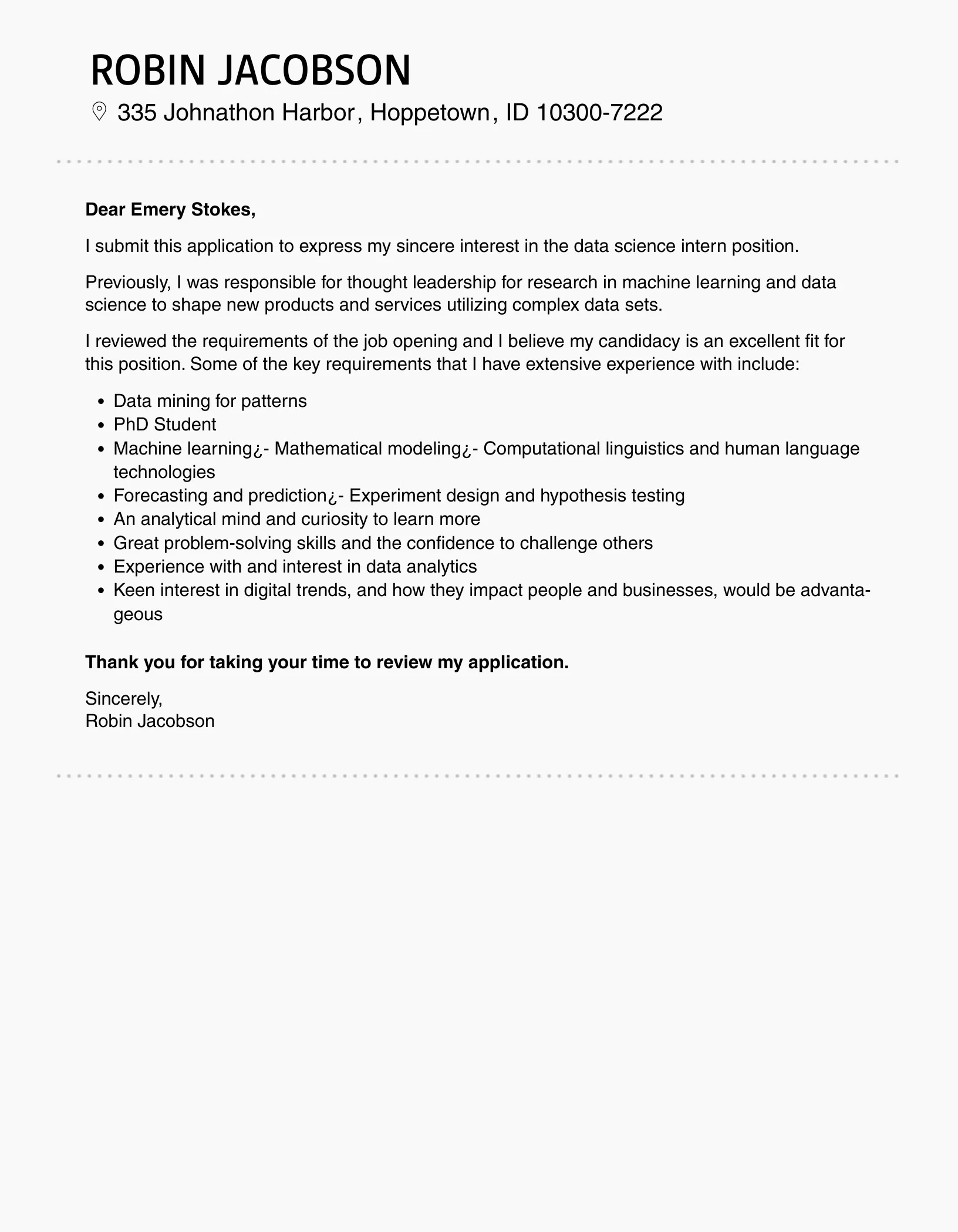Understand the Data Science Internship Cover Letter
A data science internship cover letter is your first chance to make a positive impression on a potential employer. Unlike a resume, which provides a factual overview of your skills and experience, a cover letter allows you to introduce yourself, explain your motivations, and demonstrate how your qualifications align with the specific requirements of the internship. It’s a tool to showcase your personality, enthusiasm, and understanding of the role, ultimately making you stand out from the competition. This guide provides a detailed look at how to write a compelling cover letter, increasing your chances of securing your dream data science internship. This guide provides everything you need, from understanding what makes a good cover letter to seeing examples of cover letters you can use for your next application.
Why Is a Cover Letter Important for Data Science Internships?
In the competitive field of data science, a well-crafted cover letter is essential. It’s more than just a formality; it’s a strategic tool to communicate your unique value proposition. The data science field is rapidly growing, and internship positions are highly sought after. A cover letter enables you to personalize your application, demonstrating that you’ve researched the company and understand the internship’s specific requirements. This shows initiative and genuine interest, setting you apart from applicants who might be sending out generic resumes. Furthermore, it offers an opportunity to expand on your resume, providing context to your achievements and highlighting skills that might not be immediately apparent. The cover letter is your platform to tell a story that convinces the recruiter that you are the best person for the job.
Key Components of a Data Science Internship Cover Letter
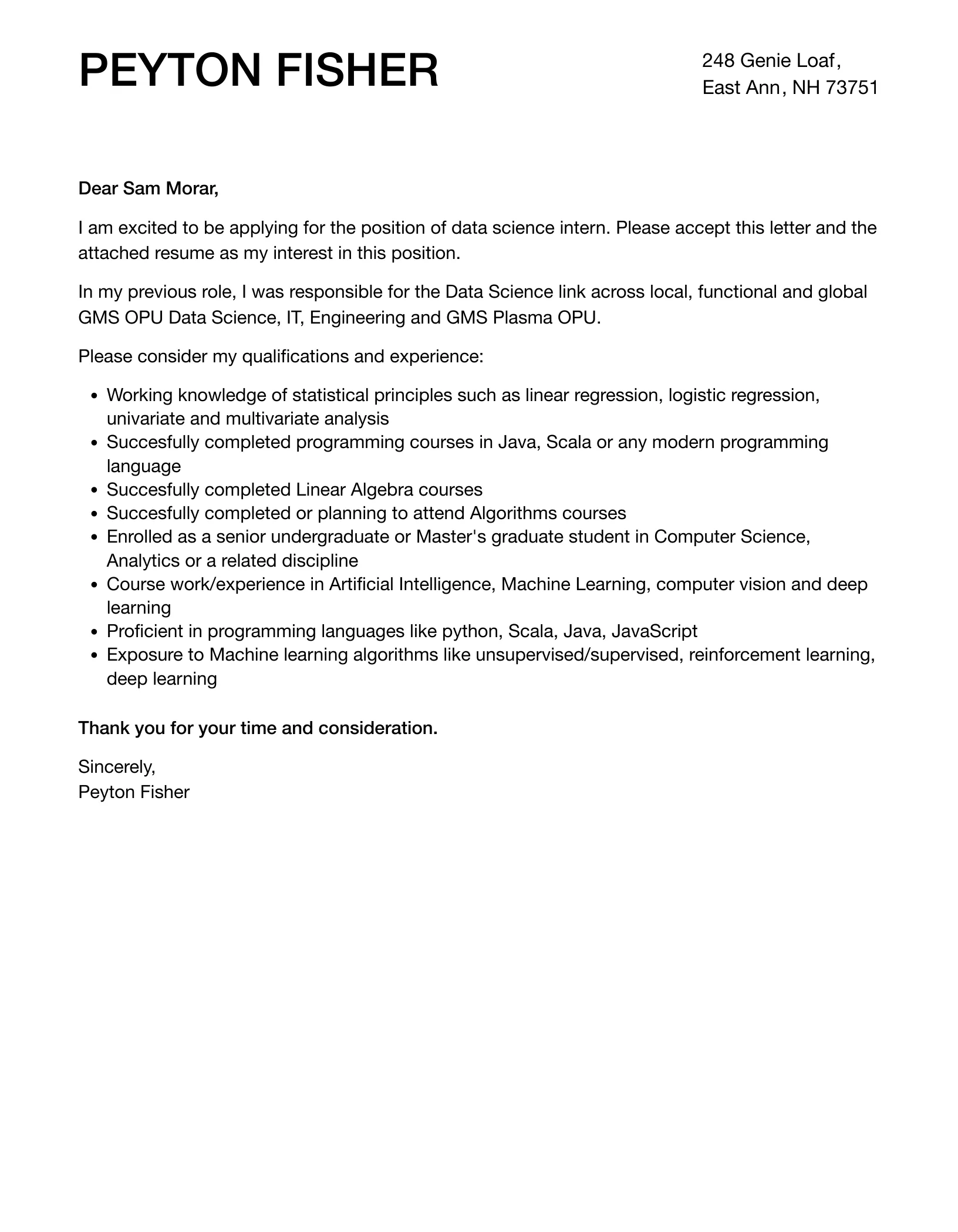
A strong data science internship cover letter comprises several key sections, each playing a crucial role in conveying your suitability for the role. These components include your contact information, the hiring manager’s information, a personalized greeting, a compelling body that highlights your skills and experiences, and a strong closing that expresses gratitude and a call to action. The following sections will guide you through each element, providing insights and examples to ensure your cover letter is impactful and professional. Mastering these components will enable you to create a cover letter that not only meets industry standards but also highlights your unique value proposition as a potential data science intern. Understanding these key components will make writing your cover letter easier.
Contact Information
Your contact information should be placed at the top of your cover letter. This typically includes your full name, phone number, email address, and a link to your LinkedIn profile or online portfolio. Ensure that your email address is professional and your LinkedIn profile is up-to-date. This section enables the hiring manager to quickly find and contact you. Double-check that all the information provided is correct and easily accessible. Providing all this information helps the recruiter reach out to you easily.
Your Name and Contact Details
Start with your full name at the top, followed by your phone number, professional email address, and links to relevant online profiles. Make sure to use a professional-sounding email address. Always double-check your contact information for accuracy. Consider including a link to your online portfolio to showcase projects.
The Hiring Manager’s Information

If possible, address the cover letter to a specific person. Research the hiring manager’s name and title. If you cannot find the hiring manager’s name, use a general greeting like ‘Dear Hiring Manager’. This shows you’ve put in the extra effort and attention to detail.
The Greeting
The greeting sets the tone for your cover letter. It should be professional and personalized. Avoid generic greetings like ‘To Whom It May Concern’. Instead, use the hiring manager’s name. If you do not know the hiring manager’s name, use a professional greeting like ‘Dear Hiring Team’. Make sure to spell the name correctly.
Personalizing Your Greeting
Always address the hiring manager by name if you know it. Researching the company and identifying the hiring manager demonstrates your interest. If you are unable to find a name, using ‘Dear Hiring Manager’ is a professional alternative. Researching the company before applying will help you with your cover letter.
The Body of Your Data Science Cover Letter
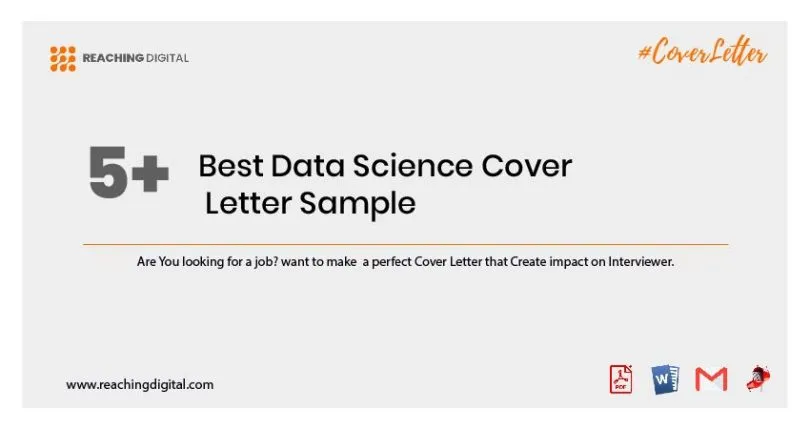
The body of your cover letter is where you articulate your interest in the internship, highlight your relevant skills and experiences, and demonstrate how you can contribute to the company. This section should be concise, engaging, and tailored to the specific job description. Clearly state your interest in the position and explain why you’re a good fit. Provide concrete examples of your skills and experiences. Quantify your achievements and showcase any relevant projects you’ve completed. Use action verbs and be specific in your descriptions. Most importantly, tailor the content to the requirements outlined in the job description. These elements will create a strong narrative that presents your qualifications.
Expressing Your Interest
In the first paragraph, clearly state the position you are applying for and where you found the listing. Show enthusiasm for the company and the internship opportunity. Briefly explain why you are interested in the role and what excites you about the company. This demonstrates your initiative and genuine interest in the position. For example, you might say, ‘I am writing to express my enthusiastic interest in the Data Science Internship at [Company Name], as advertised on [Platform].’ This immediate declaration of interest sets a positive tone and shows the hiring manager you are serious about the opportunity.
Highlighting Relevant Skills and Experiences
The next part of the body should focus on highlighting your relevant skills and experiences. Align your qualifications with the requirements listed in the job description. Provide specific examples that demonstrate your abilities. Mention any relevant coursework, projects, or previous internships. Use keywords from the job description to ensure your application is easily scanned by applicant tracking systems. Focus on skills such as programming languages (Python, R), statistical analysis, machine learning, data visualization, and any experience with relevant tools and technologies. Showcasing how your skills align with the job requirements is crucial.
Quantifying Your Achievements
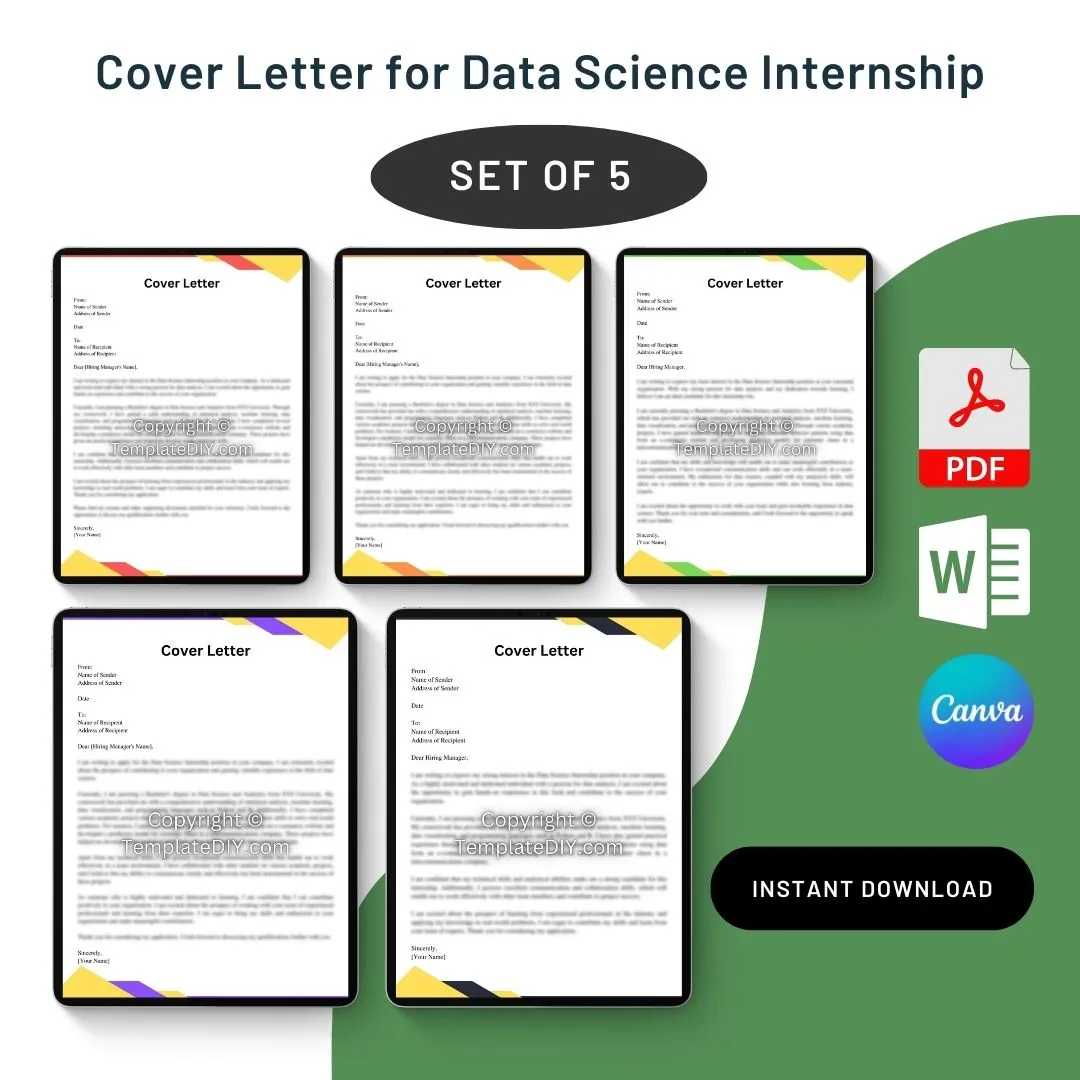
Wherever possible, quantify your achievements to provide tangible evidence of your skills. Instead of saying, ‘Improved customer satisfaction,’ say ‘Improved customer satisfaction by 15% using data-driven insights.’ Using numbers makes your accomplishments more impactful. Describe how you have used data science skills to solve problems or achieve results. Use metrics and data to highlight your contributions. Quantifiable achievements make your cover letter more compelling and demonstrate your ability to make a real impact.
Showcasing Your Data Science Projects
Data science projects are a great way to demonstrate your skills. Briefly describe any projects you have completed, including their purpose, the methods you used, and the results. Highlight the technologies and tools you used. If possible, include a link to your GitHub repository or online portfolio where the project can be viewed. This allows the hiring manager to see your work in action. Focus on the skills you utilized during the project and what you learned.
Tailoring Your Cover Letter to the Job Description
Adapt your cover letter to each specific job application. Carefully review the job description and identify the key skills and requirements. Highlight the skills and experiences that match these requirements. Use the same keywords and phrases used in the job description to help your application get through applicant tracking systems. Demonstrating that you understand the needs of the role and the company increases your chances of getting noticed. Customization is essential to show your attention to detail.
The Closing of Your Cover Letter
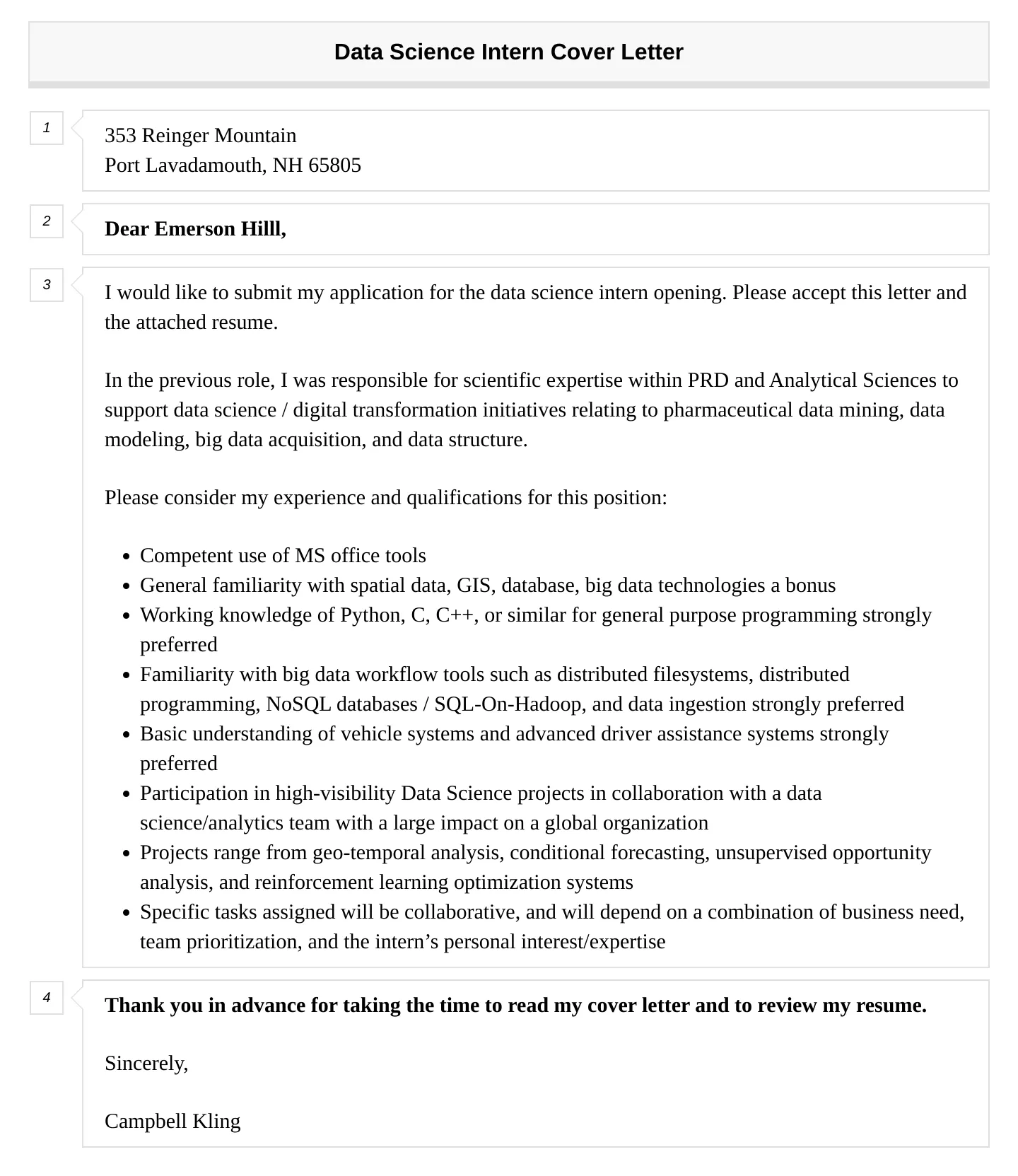
The closing of your cover letter is where you express your gratitude and provide a call to action. This section summarizes your interest, reiterates your enthusiasm, and provides the hiring manager with a clear direction on how to proceed. It leaves a lasting positive impression and encourages the next steps. This is also where you show your professionalism and leave a good last impression. A strong closing makes it easier for the recruiter to move you to the next step.
Expressing Gratitude
Thank the hiring manager for their time and consideration. Express your appreciation for the opportunity to apply. Reiterate your interest in the internship and the company. A brief and sincere expression of gratitude helps end your cover letter on a positive note.
Call to Action
In your closing paragraph, include a call to action. State that you are available for an interview and provide your contact information again. Encourage the hiring manager to contact you to discuss your application further. This helps to move the application process forward. For example, you might say, ‘I am eager to discuss my qualifications further and would welcome the opportunity to interview for this internship. Thank you again for your time and consideration. You can reach me at [Phone Number] or [Email Address].’
Data Science Internship Cover Letter Samples
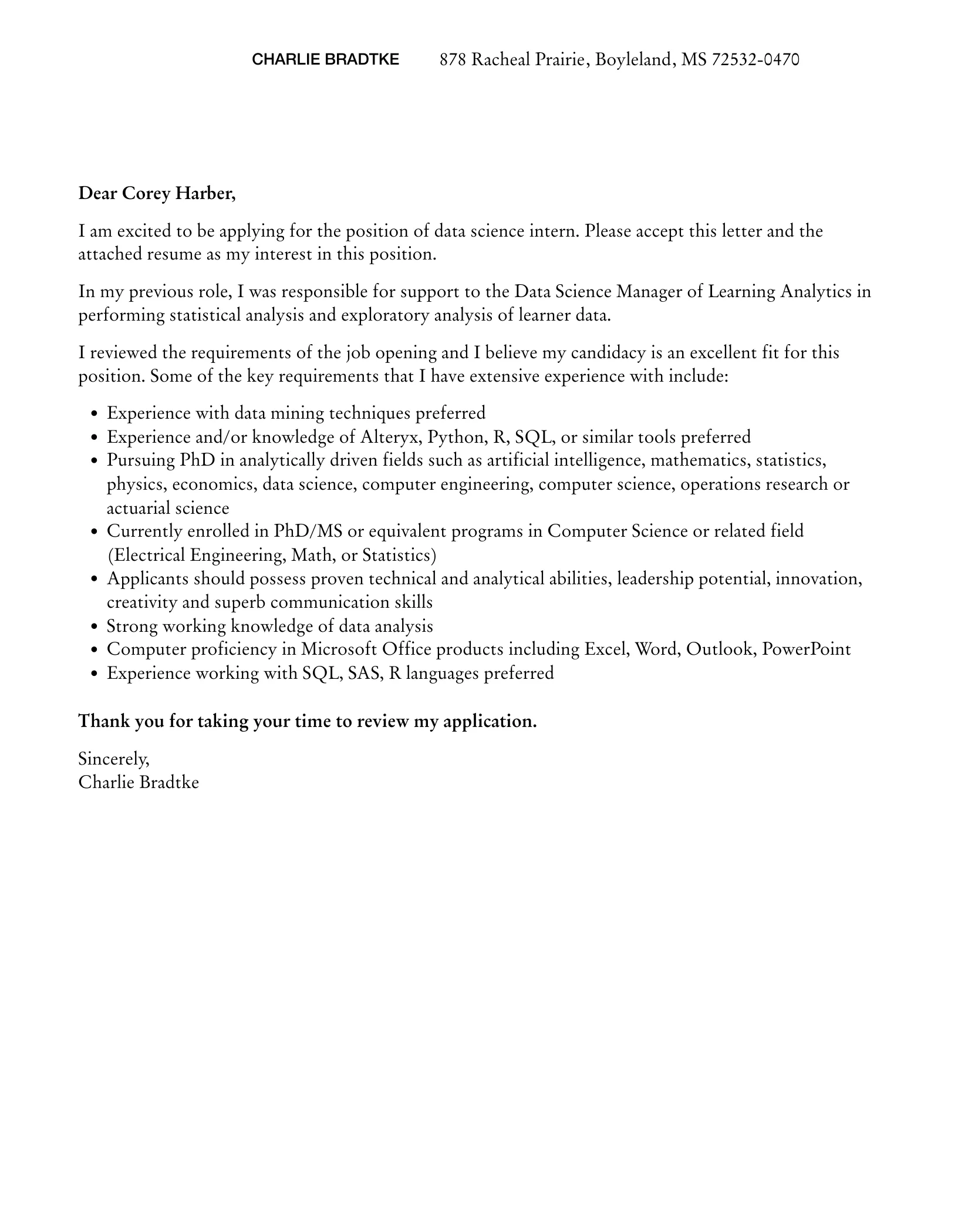
Reviewing cover letter samples can provide you with inspiration and a framework for creating your own. The following examples are tailored to different areas within data science, such as data analysis, machine learning, and general data science roles. The samples provide guidance on how to structure your cover letter and highlight your skills. Use these examples as a foundation, customizing them to your specific background and the requirements of the internship you are applying for. By seeing a sample, you can better understand what to include and how to format your cover letter. Remember to tailor each sample to the job you are applying for.
Sample Cover Letter 1 Data Analysis Focus
This sample cover letter focuses on a data analysis role, highlighting skills such as data cleaning, exploratory data analysis (EDA), and data visualization. It includes examples of how to showcase your abilities with tools like SQL, Excel, and data visualization software. This sample would be useful for those who want to highlight data analysis in their cover letter.
Sample Cover Letter 2 Machine Learning Focus
This sample covers the machine learning focus, mentioning your expertise in areas such as model building, model evaluation, and experience with programming languages. This example offers guidance on how to showcase your experience with machine learning tools and libraries. The sample provides useful guidance on how to approach your cover letter if your interests are in machine learning.
Sample Cover Letter 3 General Data Science
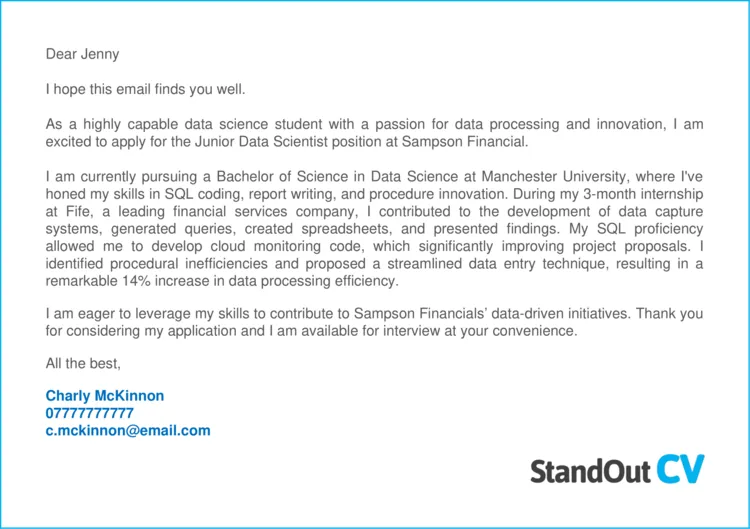
This sample provides a template for general data science roles, incorporating a broad range of skills and experiences. It showcases how to adapt your cover letter to demonstrate proficiency across different data science tasks. This sample will help you to create a strong data science internship cover letter.
Proofreading and Formatting
Proofreading and formatting are critical steps in ensuring your cover letter is professional and polished. Thoroughly review your cover letter for grammatical errors, typos, and formatting inconsistencies. Proper formatting and error-free content enhance your credibility and make a positive impression on the hiring manager. Taking the time to proofread and format correctly shows attention to detail, a quality highly valued in data science. It is also important to have someone else review your cover letter as well.
Formatting Your Cover Letter
Use a clean, readable font such as Times New Roman or Arial. Keep your font size between 10 and 12 points. Use single spacing within paragraphs and double spacing between paragraphs. Align your text to the left and use clear headings and subheadings to organize your content. Use bolding and italics sparingly to emphasize key points. Ensure your cover letter fits on one page. Maintaining a professional format makes your cover letter easy to read and visually appealing.
Proofreading for Errors
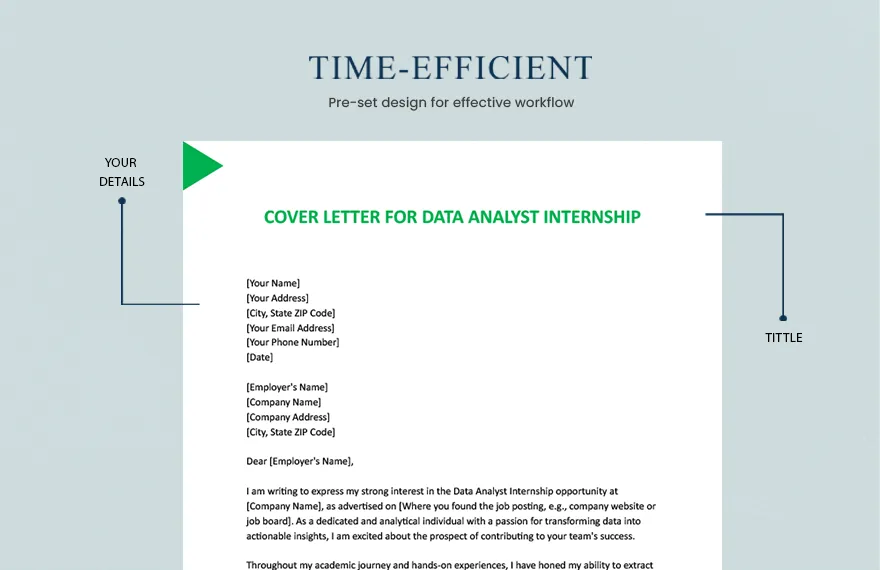
Carefully proofread your cover letter for any grammatical errors, spelling mistakes, and typos. Read your cover letter aloud to catch any awkward phrasing. Use a grammar checker and spell checker, but don’t rely on them entirely. Have someone else review your cover letter as a second pair of eyes can often catch errors you might miss. Proofreading ensures your cover letter is professional and error-free, demonstrating attention to detail.
Common Mistakes to Avoid
Avoiding common mistakes can significantly improve your cover letter and increase your chances of success. These mistakes can range from failing to tailor your letter to the job to making basic errors. Being aware of the common pitfalls allows you to create a polished and effective cover letter that stands out to the hiring manager. By avoiding these pitfalls, you will be able to make a great first impression.
Not Tailoring to the Specific Job
One of the most common mistakes is failing to tailor your cover letter to the specific job description. Sending a generic cover letter does not show that you have taken the time to research the company or understand the role’s requirements. Always customize your cover letter for each application. Highlight the skills and experiences most relevant to the job. Tailoring your cover letter is vital for demonstrating your interest and suitability.
Being Too Generic
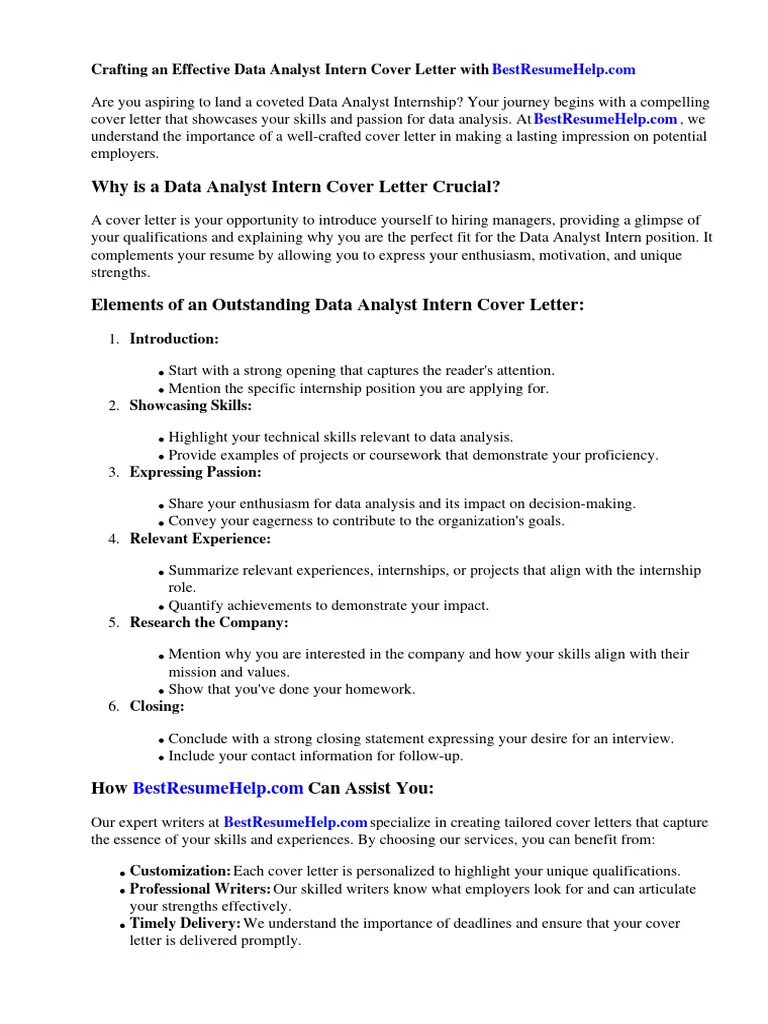
Avoid using generic phrases that don’t provide any specific information. Instead, use concrete examples and quantify your achievements. Generic statements don’t make a strong impression. Be specific about your skills and experiences. Showcase your unique value and what you bring to the table. Use concrete examples and be as specific as possible to make your cover letter compelling.
Grammatical Errors and Typos
Grammatical errors and typos are a major turnoff. Always proofread your cover letter carefully. Use a grammar checker and a spell checker. Have someone else review your cover letter for any errors you might have missed. Errors damage your credibility and suggest a lack of attention to detail. A polished, error-free cover letter demonstrates professionalism and care.
Final Thoughts and Tips for Success
Writing a successful data science internship cover letter involves careful preparation, attention to detail, and strategic communication. By following these guidelines and tips, you can create a compelling cover letter that effectively showcases your qualifications and increases your chances of landing your dream internship. Always remember to customize your cover letter for each application and tailor it to the specific role. These tips will help you stand out.
